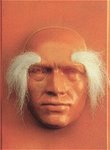
A film generating a significant amount of buzz at the Toronto International Film Festival is The Hurt Locker, directed by Kathryn Bigelow.
Although she hasn't directed many films, Bigelow's cinematic offerings can leave a strong impression. In Point Break she created what one critic on the Internet Movie Database referred to as 'the greatest surfer-action movie of all time' but it was with the release of Strange Days in 1995 that she managed to cause an even greater outpouring of emotionally affected comments.
Strange Days is not a great film (although one critic boasted it 'literally has something for everyone') but it is a good example of cyberpunk, with a nod towards William Gibson and a wink at Raymond Chandler.
Set in the last few days of the twentieth century, Strange Days stars Ralph Fiennes as an ex-cop, Nero, who deals in illegal recordings. The discs and their playback machines have become the new drugs: when the user places a device resembling a face-hugger (the script is by James Cameron, who may have been creatively influenced by his work on Aliens) on his head and closes his eyes, he experiences all sensory input as though he was the participant.
The first five minutes of the film let the audience know what to expect: Nero plays a recording and we are treated to a first person perspective of a botched robbery. It terminates when the protagonist dies.
Nero throws off the machine and berates the dealer for giving him 'black jack', or snuff. It is a disturbing scene which is paid off at the midway point when Nero receives an anonymous recording.
At first it seems similar to the initial scene, as we see a pair of white gloves breaking into a hotel room. As the door opens, we see a young woman wearing a white nightdress who becomes panic stricken when she sees the intruder. Within seconds, she has her hands tied over her head and has been incapacitated by a stun gun. The intruder now places the machine over her head.
The screenplay describes:
'[She] can now see herself as the wearer sees her....wide eyed with terror, white-lipped, weeping. And she can feel what he feels.'
When the attacker places a blindfold over her eyes, 'she can only see what he sees'. She, Nero and, by extension, the audience are forced to experience both the woman's terror and the attacker's 'exhilaration, pounding heart, flushed skin, panting breath'.
The scene, which ends in the victim's death and an image of the killer reflected in her eye, is extremely disturbing. After Nero removes the device and vomits in a shop doorway, the screenplay describes the moment as 'the worst thing he has ever experienced'.
Some male critics agreed. Paul Gambaccini, then presenter of the Radio 4 arts programme Kaleidoscope, refused to interview Bigelow because he would be able to 'do nothing but insult her'.
It is a testament to Bigelow's skill as a director that she provoked Gambaccini into providing an inadvertent example of the link between fear and scapegoating. He feels revolted because the rape scene erodes the sense of distance between the screen and the (particularly male) viewer.
Bigelow, presumably aware that a whiff of female fear is present in some pornography, uses the camera to prompt a complex emotional reaction and thus illuminates the debate on cinema violence: point of view matters.
Although Bigelow serves the audience what appears to be a traditional slasher moment (the victim is a hooker) by changing the focus, she catches the audience off guard. For once, a depiction of rape and murder is not used simply to bolster a patriarchal character's motivation to catch the assailant. It is a challenging scene and one that is arguably more disturbing because it occurs in a sci-fi film that has the tagline, 'You know you want it.'
Given Bigelow's experience making Strange Days, it is extremely possible that The Hurt Locker, a film about a bomb disposal unit in Iraq, will be important, powerful and harrowing.
Its tagline is 'You'll know it when you're in it'.


No comments:
Post a Comment